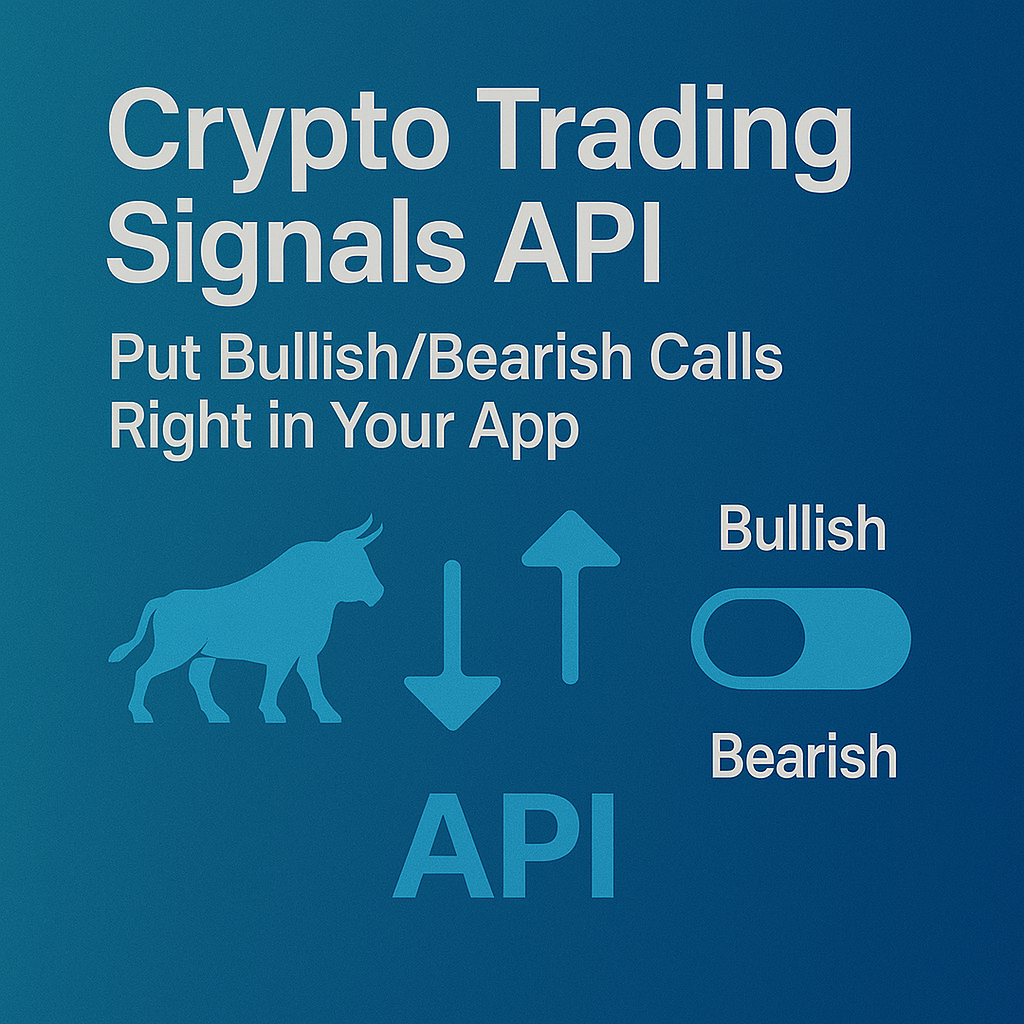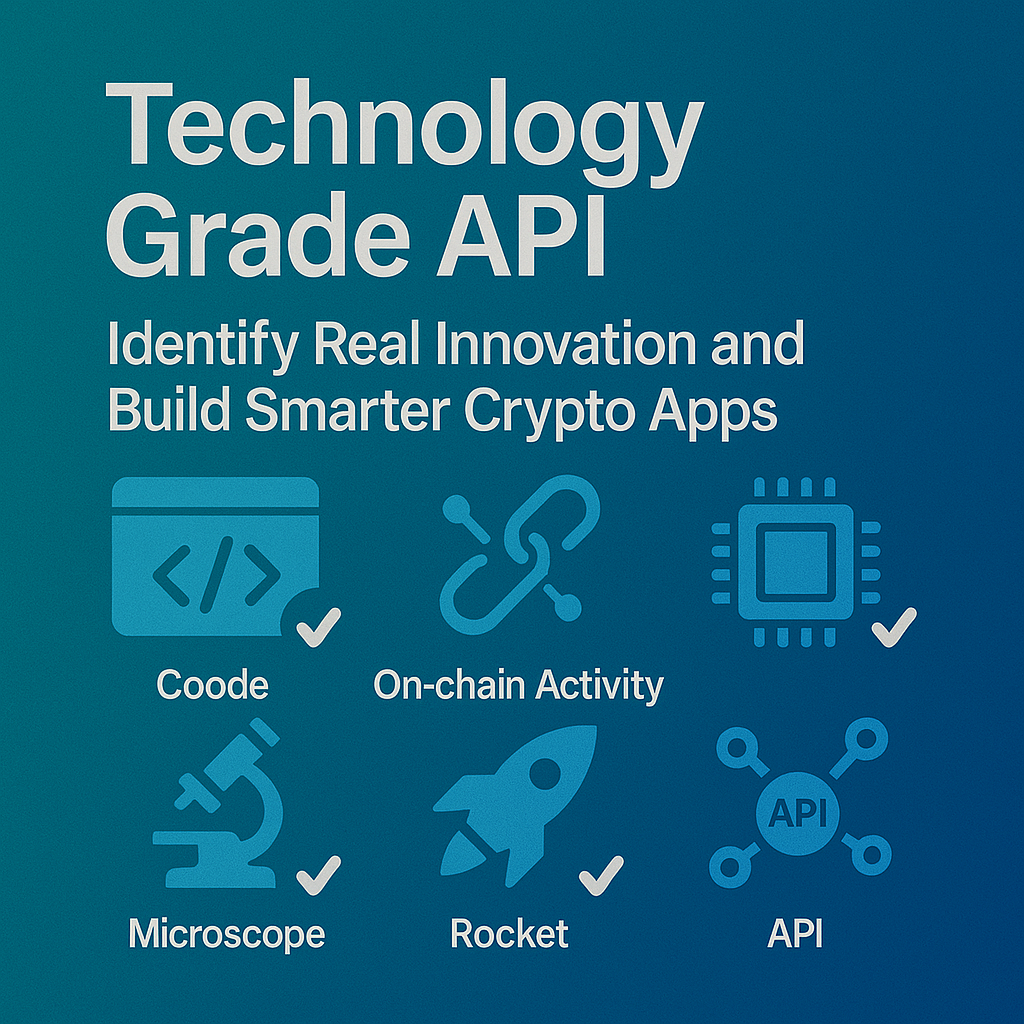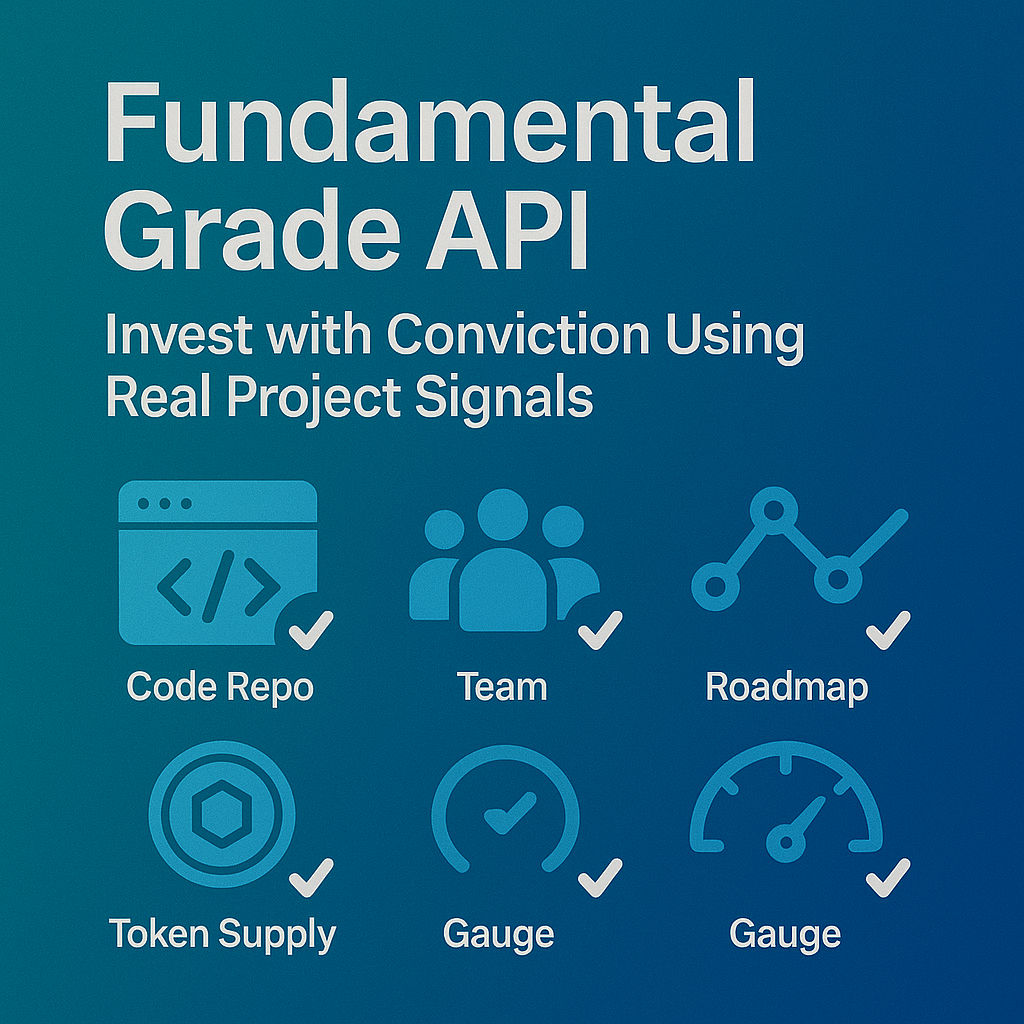Top Crypto Trading Platforms in 2025







%201.svg)
%201.svg)
Big news: We’re cranking up the heat on AI-driven crypto analytics with the launch of the Token Metrics API and our official SDK (Software Development Kit). This isn’t just an upgrade – it's a quantum leap, giving traders, hedge funds, developers, and institutions direct access to cutting-edge market intelligence, trading signals, and predictive analytics.
Crypto markets move fast, and having real-time, AI-powered insights can be the difference between catching the next big trend or getting left behind. Until now, traders and quants have been wrestling with scattered data, delayed reporting, and a lack of truly predictive analytics. Not anymore.
The Token Metrics API delivers 32+ high-performance endpoints packed with powerful AI-driven insights right into your lap, including:
Getting started with the Token Metrics API is simple:
At Token Metrics, we believe data should be decentralized, predictive, and actionable.
The Token Metrics API & SDK bring next-gen AI-powered crypto intelligence to anyone looking to trade smarter, build better, and stay ahead of the curve. With our official SDK, developers can plug these insights into their own trading bots, dashboards, and research tools – no need to reinvent the wheel.
%201.svg)
%201.svg)
Hype is loud, but code is what lasts. The Technology Grade API helps you measure the engineering strength behind a token—scalability, innovation, and real code quality—so you can prioritize serious projects in your bots, dashboards, or research tools. In this guide, you’ll query the /v2/technology-grade endpoint, embed the score in your UI, and ship a feature that turns technical due diligence into a single actionable signal. Start by grabbing your key at Get API Key, Run Hello-TM to validate your first call, then Clone a Template to go live fast.
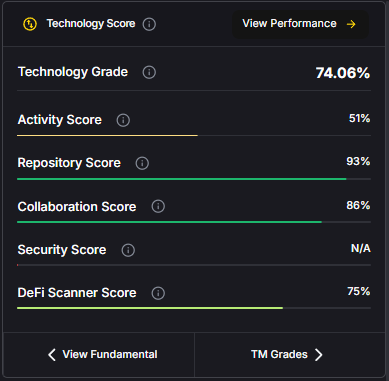
Separate hype from substance. Whitepapers and roadmaps are cheap; shipped code, throughput, and upgrade cadence are not. The Technology Grade API rolls engineering reality into a comparable score so you can rank ecosystems, filter listings, and surface projects with staying power.
Faster diligence, clearer decisions. For bot builders, Technology Grade is an upstream filter that keeps low-quality projects out of your universe. For dashboard builders, it adds credibility—users can see why a project ranks well. And for screeners, it’s a one-score signal that’s easy to sort, badge, and alert on with low latency.
For the Technology Grade information, check the top right of the API Reference. You'll find the cURL request to connect effortlessly.
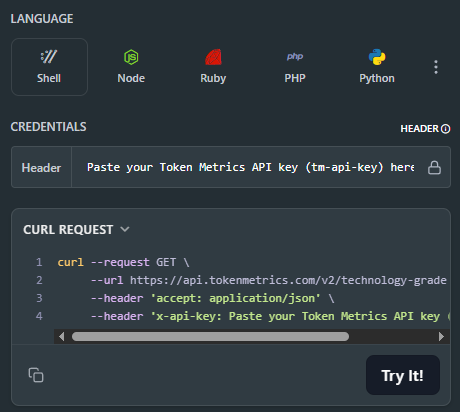
Kick off from quickstarts in the docs—fork a dashboard or screener and deploy. Validate your environment with Run Hello-TM, then scale usage. When you need higher limits and SLAs, compare API plans.
Technology Grade synthesizes engineering-centric evidence—such as throughput/scalability, rate of innovation (feature velocity, upgrade cadence), and code quality (maintainability, robustness cues)—into a normalized score and grade (e.g., Strong / Average / Weak). It’s designed to be comparable across projects and stable enough to inform filters, tiers, and badges.
At query time, you request /v2/technology-grade?symbol=<ASSET>. The response includes the headline score and component scores you can display in bars or a radar chart. For dashboards with many assets, use batched calls and short-TTL caching. If you push upgrade/downgrade alerts, queue notifications or use webhooks to avoid bursty polling.
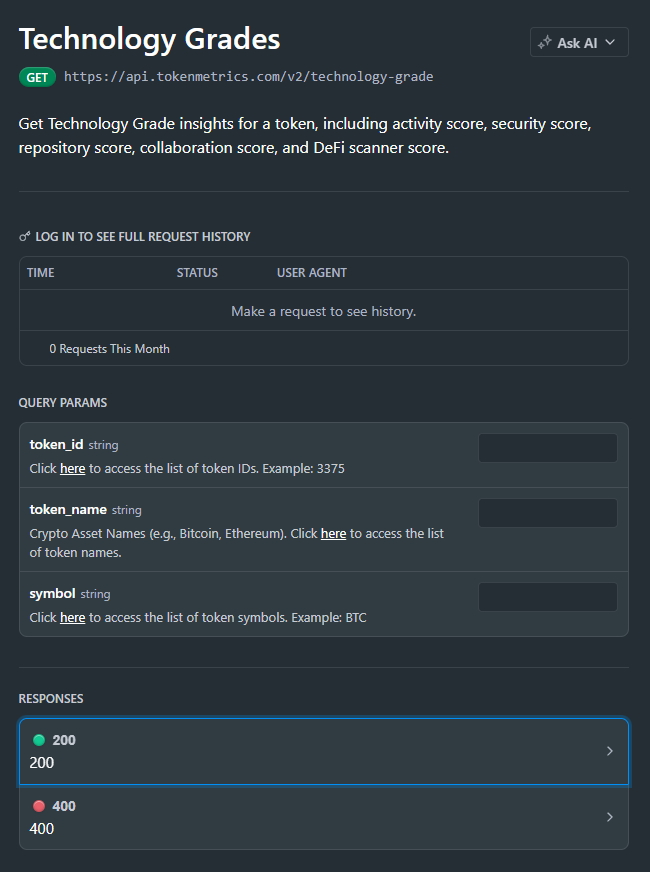
1) What does the Technology Grade API return?
A JSON payload with an overall score/grade plus component scores (e.g., scalability, innovation, code quality) and timestamps. Use the overall score for ranking and components for explanation.
2) Is this real-time, and what about latency/SLOs?
The endpoint is engineered for predictable latency suitable for dashboards and filters. For frequent refresh or alerts, combine short-TTL caching with queued jobs or webhooks to minimize round-trips.
3) How should I combine Technology Grade with other signals?
A common pattern: Technology Grade (engineering quality) + Fundamental Grade (business quality) + TM Grade (technicals/sentiment) + Trading Signals (timing) + Support/Resistance (risk placement).
4) How “accurate” is Technology Grade?
It’s an opinionated synthesis of engineering evidence, not financial advice. Use it as part of a diversified framework; validate with your own backtests and risk controls.
5) Do you provide SDKs or examples?
You can integrate via REST (JS/Python examples above). The docs include quickstarts, Postman collections, and templates—start by Run Hello-TM.
6) Polling vs webhooks for grade changes?
For UI pages, cached polling is fine. For alerts (upgrades/downgrades), prefer webhooks or scheduled jobs to avoid spiky traffic and rate-limit issues.
7) Pricing, limits, and enterprise SLAs?
Begin free and scale up as needed. See API plans for allowances; enterprise SLAs and support are available.
%201.svg)
%201.svg)
Most traders chase price action; Fundamental Grade API helps you see the business behind the token—community traction, tokenomics design, exchange presence, VC signals, and DeFi health—consolidated into one score you can query in code. In a few minutes, you’ll fetch Fundamental Grade, render it in your product, and ship a due-diligence UX that drives trust. Start by grabbing your key at the Get API Key page, Run Hello-TM to verify your first call, then Clone a Template to go live fast.
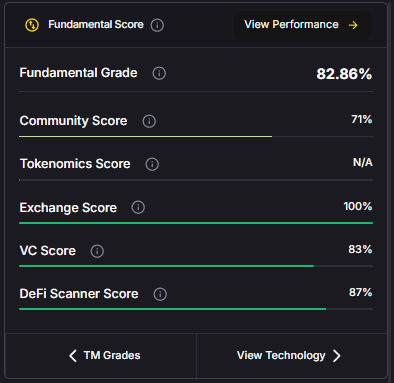
Beyond price, toward quality. Markets are noisy—hype rises and fades. Fundamental Grade consolidates hard-to-track signals (community growth, token distribution, liquidity venues, investor quality, DeFi integrations) into a clear, comparable score. You get a fast “is this worth time and capital?” answer for screening, allocation, and monitoring.
Build trust into your product. Whether you run an investor terminal, exchange research tab, or a portfolio tool, Fundamental Grade lets users justify positions. Pair it with TM Grade or Quantmetrics for a balanced picture: what to buy (fundamentals) and when to act (signals/levels).
The Fundamental Grade is easily accessible in the top right of the API Reference. Grab the cURL request for seamless access!
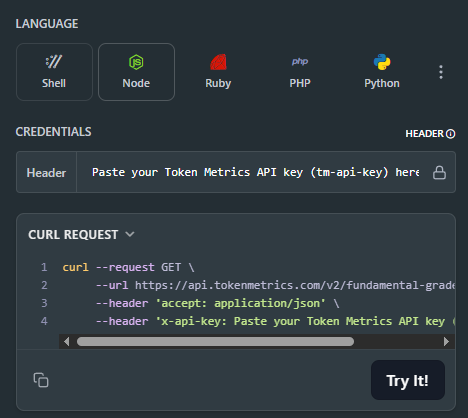
👉 Ready to build? Get API Key • Run Hello-TM • Clone a Template
Kick off from our quickstarts—fork a dashboard or screener template, plug your key, and deploy. If you’re new here, Run Hello-TM first to confirm your environment, then scale into product features. When you outgrow the free tier, compare API plans.
Fundamental Grade aggregates multiple project-quality signals into a normalized score and label (e.g., Strong / Average / Weak). Typical sub-signals include:
At query time, you call /v2/fundamental-grade with a symbol; responses include the overall score plus component scores you can visualize. For dashboards with many assets, batch fetches and short-TTL caching keep pages responsive. If you push alerts (e.g., “Fundamental Grade upgraded”), prefer webhooks or queued jobs to avoid hammering the API.
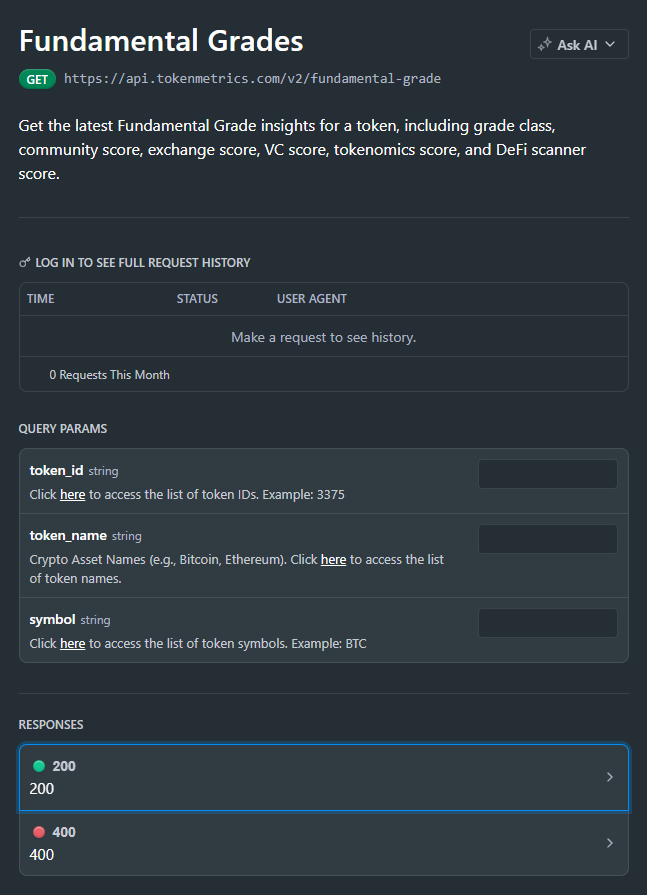
1) What does the Fundamental Grade API return?
A JSON payload with the overall score/grade plus component scores (e.g., community, tokenomics, exchange presence, VC backing, DeFi health) and timestamps. Use the overall grade for ranking and component scores for explanations.
2) How fast is the endpoint? Do you publish SLOs?
The API is engineered for predictable latency. For high-traffic dashboards, add short-TTL caching and batch requests; for alerts, use jobs/webhooks to minimize round-trips.
3) Can I combine Fundamental Grade with TM Grade or signals?
Yes. A common pattern is Fundamental Grade for quality filter + TM Grade for technical/sentiment context + Trading Signals for timing and Support/Resistance for risk placement.
4) How “accurate” is the grade?
It’s an opinionated synthesis of multiple inputs—not financial advice. Historical studies can inform usage, but past performance doesn’t guarantee future results. Always layer risk management and testing.
5) Do you offer SDKs and examples?
You can use REST directly (see JS/Python above). The docs include quickstarts, Postman, and ready-to-clone templates—start with Run Hello-TM.
6) Polling vs webhooks for fundamentals updates?
For UI pages, cached polling works well. For event-style notifications (upgrades/downgrades), prefer webhooks or scheduled jobs to avoid spiky traffic.
7) What about pricing, limits, and enterprise SLAs?
Begin free and scale as you grow. See API plans for allowances; enterprise SLAs and support are available—contact us.
%201.svg)
%201.svg)
Cluttered charts and whipsaw price action make it hard to act with conviction. The TM Grade API turns that noise into a single, opinionated signal you can build on—ideal for trading bots, dashboards, and research tools. In this guide, you’ll pull TM Grade in code, see how it powers products, and ship something useful in minutes. Start with the Get API Key, then Run Hello-TM in the docs and Clone a Template to go live fast.
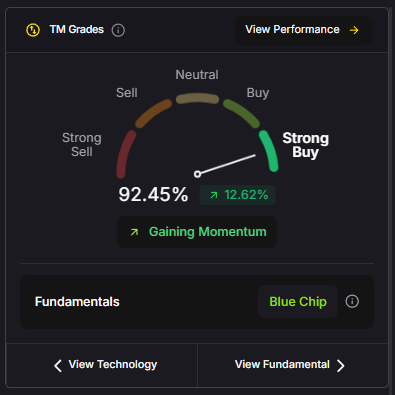
One score, clear decision. TM Grade distills technicals, sentiment, and momentum into a single, interpretable value from Strong Sell → Strong Buy. Instead of juggling indicators, you get an opinionated, trade-ready signal you can rank, alert on, and route into strategies.
Built for builders. Developers integrate TM Grade to filter universes, power dashboards, or trigger bots—with predictable performance and a schema designed for programmatic use. Pair it with webhooks and caching to slash latency and polling costs.
In the top right of the API Reference you can find the curl request for your desired language. This is what you can use to access the TM Grade endpoint.
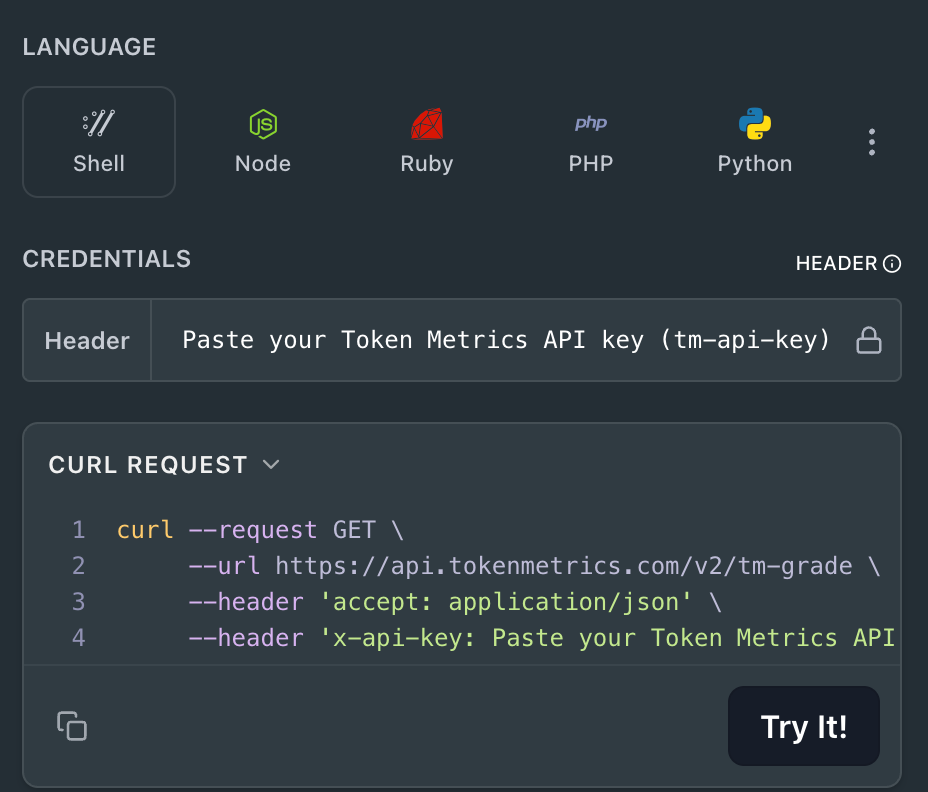
👉 Ready to go further? Get API Key • Run Hello-TM
You can start from our quickstarts in the docs—fork, plug your key, and deploy in minutes. Run Hello-TM to see the first call succeed, then scale into a bot or dashboard. When you’re ready for higher limits, compare API plans.
TM Grade blends multiple evidence streams—technical momentum, market structure, sentiment, and other model inputs—into a single normalized score (e.g., 0–100) and a label (Strong Sell to Strong Buy). This opinionated synthesis is what separates TM Grade from raw market data: it’s designed to be actionable.
Polling vs webhooks. For screens and dashboards, lightweight polling (or cached fetches) is fine. For trading agents and alerting, use webhooks or short polling with backoff and caching to cut latency and call volume. Combine TM Grade with endpoints like /v2/trading-signals for timing or /v2/resistance-support for risk placement.
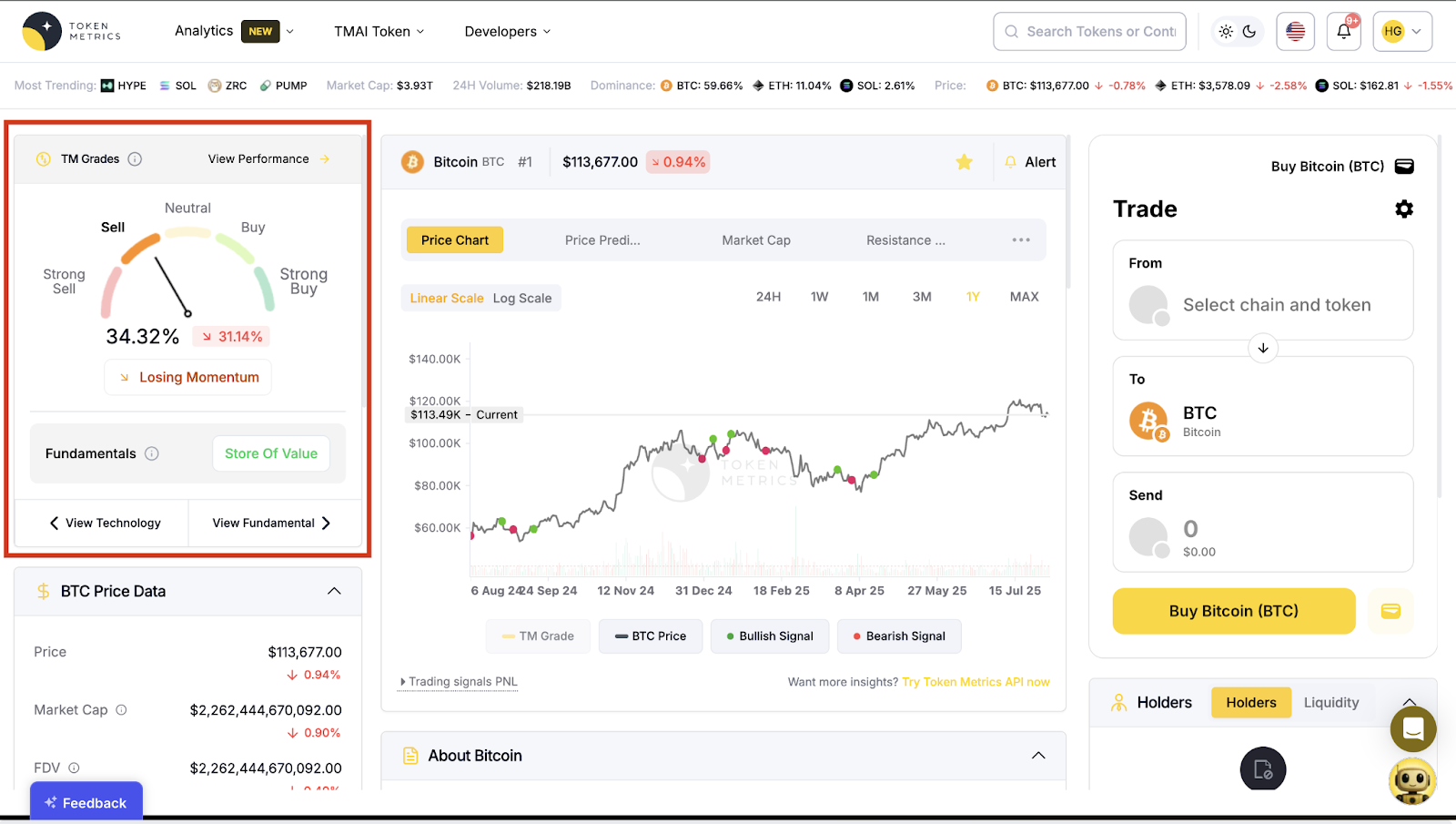
1) What does the TM Grade API return?
A JSON payload with fields like symbol, score (e.g., 0–100), and a categorical grade from Strong Sell to Strong Buy, designed for programmatic ranking, filtering, and display.
2) How fast is it? Do you have latency/SLOs?
TM endpoints are engineered for reliability with predictable latency. For mission-critical bots, add short-TTL caching and webhooks to minimize round-trips and jitter.
3) Can I use TM Grade in trading bots?
Yes. Many developers use TM Grade to pre-filter tokens and pair it with /v2/trading-signals for entries/exits. Always backtest and paper-trade before going live.
4) How accurate is TM Grade?
TM Grade is an opinionated model synthesizing multiple inputs. Backtests are illustrative—not guarantees. Use it as one component in a diversified strategy with risk controls.
5) Do you have SDKs and examples?
Yes—JavaScript and Python examples above, plus quickstarts and templates in the docs: Run Hello-TM.
6) Polling vs webhooks—what should I pick?
Dashboards: cache + light polling. Bots/alerts: prefer webhooks (or event-driven flows) to reduce latency and API usage.
7) Pricing, limits, and enterprise SLAs?
You can start free and scale up as you grow. See API plans for rate limits and tiers. Enterprise options and SLAs are available—contact us.

%201.svg)
%201.svg)
APIs, or Application Programming Interfaces, serve as essential tools in modern software development by allowing different applications to communicate and work together efficiently. Understanding how APIs work is fundamental for developers, businesses, and enthusiasts exploring technology or crypto environments where APIs facilitate seamless data exchange and integration.
An API is essentially a set of rules and protocols that enables different software applications to interact. It defines the methods and data formats that programs can use to request and exchange information. Through these interfaces, complex software systems can communicate without having to know the internal workings of each other, promoting modularity and efficiency.
APIs operate as intermediaries between client requests and server responses. When a user interacts with an application, the underlying API sends structured requests to a server which processes these requests and sends back the appropriate data or service. This process involves:
This exchange allows integration across services, such as connecting a mobile app to a database or enabling a crypto trading platform to access market data.
APIs are implemented using diverse standards and protocols depending on their purpose:
Understanding these protocols helps in selecting or designing the appropriate API solution for specific use cases.
In the cryptocurrency domain, APIs facilitate access to market data, trading functionalities, and analytics. Crypto APIs, including the Token Metrics API, provide developers and analysts with programmatic access to detailed metrics, historical data, and real-time updates.
Furthermore, AI-driven tools leverage APIs to gather and analyze vast datasets efficiently. Token Metrics, for example, integrates AI to enhance crypto research and analytics. Accessing this data programmatically via the Token Metrics API allows for automated strategies and custom insights without manual intervention.
To maximize the benefits of APIs, consider the following best practices:
For example, the best crypto API solutions often provide sandbox environments to allow safe experimentation with live-like data.
Crypto trading platforms utilize APIs to enable seamless order placements, market monitoring, and account management. Integrating APIs allows platforms to connect with external services or enable bots and third-party tools to interact with user accounts securely.
When exploring a crypto trading platform, understanding the underlying API capabilities helps users and developers gauge integration potential and automation possibilities.
The API ecosystem continues evolving with trends such as:
Monitoring developments through platforms like Token Metrics can keep users informed about innovations impacting crypto and tech sectors.
APIs are foundational in today's interconnected digital landscape, enabling diverse applications to communicate and unlock new functionalities efficiently. Recognizing how APIs work empowers users and developers to harness technology effectively across industries, particularly within crypto and AI-driven research contexts.
Utilizing APIs such as the Token Metrics API provides structured access to valuable data and analytics, fostering innovation and informed analysis.
This content is for educational purposes only and does not constitute financial or investment advice. Readers should conduct their own research and consult professionals as needed.

%201.svg)
%201.svg)
A Web API is an interface that allows different software applications to communicate with each other over the internet. Essentially, it is a set of protocols and tools for building and interacting with software applications remotely via the web. APIs enable developers to access specific functionalities or data from external services without having to understand the internal workings of those services.
Understanding the basic components of Web APIs helps clarify their importance in modern software development:
Web APIs function by receiving requests from clients and returning appropriate responses:
This request-response mechanism allows seamless integration between diverse systems and applications, facilitating interoperability and automation.
There are several types of Web APIs, each suited for different purposes:
Web APIs are foundational to many modern software ecosystems. They enable:
For example, the Token Metrics API provides a robust crypto API allowing seamless access to cryptocurrency data and metrics, supporting data-driven decision-making in crypto trading platforms.
Securing a Web API is crucial due to its exposure over the internet. Important measures include:
Leveraging Web APIs in software development brings multiple benefits:
Integrating AI and advanced data analytics with Web APIs can improve insights and user experiences. For instance, in the crypto domain, AI-driven platforms like Token Metrics utilize APIs to aggregate data and provide analytical ratings that inform research and trading strategies without offering financial advice.
By automating data retrieval via Token Metrics API and applying machine learning, businesses can unlock deeper insights while maintaining neutrality and compliance.
To effectively utilize Web APIs, consider these practical steps:
Web APIs are essential building blocks for modern digital applications, enabling diverse systems to communicate over the internet efficiently. Whether creating mobile apps, connecting to blockchain data via a crypto API, or integrating analytics platforms like Token Metrics, understanding Web APIs empowers developers and businesses to innovate responsively.
Adhering to best practices in design and security ensures APIs remain reliable and safe tools within the technology ecosystem.
This article is for educational and informational purposes only. It does not constitute investment advice, financial recommendations, or endorsements of any products or services. Readers should conduct their own research and consult professional advisors before making decisions related to cryptocurrency or technology investments.

%201.svg)
%201.svg)
In the rapidly evolving cryptocurrency landscape, Access to reliable and comprehensive APIs has become essential for developers, analysts, and businesses aiming to integrate blockchain data or build crypto-focused applications. As we approach 2025, understanding which APIs offer robust features, extensive data coverage, and advanced analytical capabilities is critical to making informed technology choices. This post provides an analytical overview of the best crypto APIs available in 2025, focusing on technical features, data reliability, and integration possibilities.
A crypto API is an application programming interface that facilitates access to cryptocurrency data and services. It typically provides endpoints to retrieve market data, historical prices, blockchain statistics, transaction data, order book snapshots, and other relevant crypto metrics. Developers and analysts use these APIs to collect data for research, build trading bots, track portfolio performance, or power analytics platforms.
In 2025, crypto APIs increasingly integrate AI-enhanced analytics and machine learning capabilities to offer predictive insights and streamline data interpretation.
Choosing the best crypto API involves multiple factors that influence usability and effectiveness:
Among many providers, some stand out based on these criteria.
AI integration in crypto APIs represents a significant advancement heading into 2025. Providers like the Token Metrics API enhance raw data with predictive models and rating systems that help developers and analysts prioritize research focus. AI can automate pattern recognition, detect anomalies, and estimate potential impacts of market factors from vast datasets.
This additional layer moves crypto APIs beyond simple data delivery toward becoming comprehensive research tools, improving operational efficiency for platforms dealing with big data.
When employing a crypto API, consider the following best practices:
Modern crypto trading platforms rely heavily on APIs for market data and trade execution. For instance, Token Metrics offers tools that integrate with various APIs to provide an enhanced user experience, combining data analytics with trading functionalities.
Choosing APIs that support trading-related features, such as order placement and balance checks, alongside data retrieval, is beneficial for building seamless crypto trading platforms.
When utilizing crypto APIs, keep these points in mind:
In 2025, the best crypto APIs will be those that combine extensive data coverage with advanced analytical capabilities. The integration of AI, as exemplified by the Token Metrics API, sets a new standard for developers and researchers aiming for deeper insights. While data quality and reliability remain paramount, the ongoing refinement of crypto APIs will likely focus on enhancing user control, predictive analysis, and ease of integration.
Exploring APIs with a critical, research-oriented approach remains essential for anyone harnessing crypto data, and tools like Token Metrics demonstrate how combining market data with AI can support comprehensive crypto ecosystems.
This blog post is intended for educational purposes only and does not constitute financial advice, investment recommendations, or solicitations. Always conduct your own research and consult with professional advisers before making any financial decisions related to cryptocurrencies.

%201.svg)
%201.svg)
In the fast-evolving landscape of digital finance, the year 2025 brings renewed interest in tools that facilitate efficient and accurate access to cryptocurrency data. APIs (Application Programming Interfaces) serve as the backbone connecting various applications to real-time and historical market, blockchain, and transactional data. This article explores the 10 best cryptocurrency APIs in 2025, emphasizing their features, data coverage, and potential uses within the cryptocurrency and blockchain ecosystem. Understanding the capabilities of these APIs can help developers, analysts, and businesses build insightful applications, conduct data-driven research, and enhance crypto trading strategies.
Cryptocurrency APIs provide structured data access ranging from coin prices, market capitalization, trading volumes, blockchain metrics, to wallet information. They offer endpoints that facilitate seamless integration with various systems such as crypto trading platforms, portfolio trackers, data analytics tools, and research applications. The choice of a crypto API depends on factors including data accuracy, latency, historical data availability, ease of use, pricing, and compatibility with AI-driven research tools. Notably, the Token Metrics API has emerged as a prominent solution providing extensive market data and analytics for developers.
In compiling the top 10 cryptocurrency APIs, several key criteria were considered:
While APIs supply raw and processed data, their integration with advanced analytical and AI tools is critical for comprehensive crypto trading and research strategies. Platforms such as the crypto trading platform Token Metrics use AI-powered models combined with API data streams to generate quantitative insights and ratings. These assist users in making informed research assessments by evaluating coin fundamentals, sentiment, and market trends without endorsing specific investments.
Developers and analysts utilizing cryptocurrency APIs should consider structuring API outputs into machine-readable formats optimized for data science workflows. Combining multiple sources, for example, market data from CoinGecko with on-chain metrics from Glassnode, can provide multidimensional perspectives facilitating robust scenario analysis and trend forecasting.
The landscape of cryptocurrency APIs in 2025 is rich and varied, catering to diverse needs from market data aggregation to in-depth blockchain analytics. Selecting the best crypto API involves balancing coverage, reliability, and compatibility with analytical frameworks. The Token Metrics API, among the leading options, exemplifies how comprehensive data and AI integration can support sophisticated crypto research workflows.
By leveraging these APIs and complementing them with AI-powered platforms such as Token Metrics, developers and analysts can navigate the complex digital asset market with enhanced clarity and data-driven understanding.
This article is for educational and informational purposes only and does not constitute financial advice. Cryptocurrency markets carry inherent risks, and users should conduct their own research and consider consulting professional advisors before making any financial decisions.

%201.svg)
%201.svg)
As the blockchain and crypto ecosystems continue to evolve rapidly, access to reliable and comprehensive cryptocurrency data through APIs remains vital for developers, analysts, and businesses. APIs facilitate the integration of real-time market data, historical analytics, and on-chain information into applications and services. With 2025 shaping up to further advance the crypto landscape, selecting the right crypto API can significantly impact the quality of data-driven insights and automation capabilities.
This article explores the 5 best cryptocurrency APIs in 2025, focusing on their features, data coverage, and analytical strengths to support developers and researchers in making informed technology choices. We also highlight the role of AI-driven tools like Token Metrics API in enhancing crypto data research.
Choosing the best crypto API requires evaluating several key factors beyond mere price feeds. Important criteria include:
The Token Metrics API stands as a leading choice for 2025. It combines traditional market data with AI-powered analytics, fundamental scores, and predictive signals. This fusion allows users to enrich their platforms with both raw data and research-grade insights.
Key Features:
Further, Token Metrics offers a complementary crypto trading platform that leverages this API, showcasing practical implementation in trading research.
CoinGecko remains one of the most popular free and paid crypto APIs, favored for its extensive token database and community-focused data. It excels at delivering real-time pricing, volume data, and detailed token metadata including developer activity and liquidity scores.
Key Features:
CryptoCompare has built a reputation for combined market data and social sentiment in a single API package. Its focus extends beyond spot prices to include derivatives and exchange-level metrics, making it useful for comprehensive market analysis.
Key Features:
Nomics delivers high-quality primary market data emphasizing transparency and accuracy. Their API offers aggregated pricing, supply data, and exchange volume metrics with premium tiers providing enhanced data granularity.
Key Features:
Glassnode is a leader in on-chain analytics, offering APIs that provide deep blockchain-level insights beyond market prices. Its datasets include wallet behavior, transaction flows, and network health indicators, making it ideal for fundamental blockchain research.
Key Features:
Utilizing crypto APIs efficiently involves defining clear objectives—whether for portfolio tracking, app development, or research. Developers and analysts should consider combining multiple data sources to obtain a multidimensional view of the markets.
Incorporating AI-based analytics, such as those offered through the Token Metrics API, can augment traditional price and volume data by providing predictive insights and risk assessments. This integration supports more nuanced research and decision-making processes.
It is also important to monitor API usage limits, latency, and data update frequencies to ensure smooth operation of dependent applications.
In the dynamic and data-intensive world of cryptocurrency, accessing robust and feature-rich APIs is fundamental to gaining insights and building competitive products. The top 5 cryptocurrency APIs for 2025 highlighted here present options catering to varied needs—from real-time market data to advanced AI-enabled analytics and on-chain metrics.
Among them, the Token Metrics API distinguishes itself by combing comprehensive crypto market data with AI-enhanced predictive research, making it a valuable resource for projects seeking to integrate both fundamental and technical perspectives.
Those engaged in crypto development and research may benefit from exploring these APIs in alignment with their specific analytical or operational requirements.
This content is for educational and informational purposes only. It does not constitute financial, investment, or legal advice. Users should conduct their own research and consult professionals before relying on any cryptocurrency data or platforms.

%201.svg)
%201.svg)
In today’s digital ecosystem, API platforms serve as critical infrastructure for enabling seamless communication between software applications. Whether facilitating data exchange, integration, or automation, API platforms empower developers and organizations to build scalable and modular systems adaptable to evolving technological needs.
This article explores the concept of API platforms with a focus on their relevance in various industries, including their increasing role in crypto trading environments where secure and reliable APIs support advanced analytics and automation.
An API platform is a suite of tools, services, and technologies designed to create, manage, and monitor Application Programming Interfaces (APIs). It offers developers a structured environment to develop APIs that enable software components to interact efficiently. Key features typically include:
For example, the Token Metrics API represents a contemporary crypto API platform offering comprehensive data endpoints to support quantitative analysis and integration within broader crypto trading platforms.
Organizations embracing API platforms can unlock several advantages:
These features are particularly crucial in crypto-related APIs where timeliness, accuracy, and security are paramount—for instance, when utilizing a crypto API to inform automated trading decisions within a crypto trading platform.
The cryptocurrency space has rapidly adopted API platforms to support data-driven trading and analytics. Crypto APIs provide access to market data, pricing feeds, on-chain information, and sentiment metrics. These APIs enable developers and analysts to embed real-time data effortlessly into their applications or trading bots.
For example, Token Metrics API delivers AI-driven crypto asset ratings and analytics that enhance decision support systems. Such integrations form the backbone of sophisticated crypto trading platforms, allowing users to research fundamentals and perform technical analysis with the aid of advanced algorithms.
Selecting the right API platform depends on specific organizational needs. Several factors to evaluate include:
Platforms like Token Metrics API exemplify these attributes, particularly in the crypto sector where precision and security are vital.
AI-driven platforms can augment API capabilities by providing predictive analytics, anomaly detection, and automated decision support. Combining APIs with AI tools enhances the value extracted from data streams. For instance, Token Metrics offers AI-powered insights accessible through their API platform, providing structured ratings and metrics that can be integrated into broader trading applications.
Such integrations facilitate rapid, data-backed evaluations without manual intervention, improving operational efficiency while supporting developers and analysts with actionable intelligence.
Successful integration of API platforms can be supported by adhering to the following principles:
For developers working in crypto markets, relying on a specialized crypto API platform that integrates seamlessly with AI research components such as those from Token Metrics can markedly enhance the robustness of their applications.
API platforms represent a foundational element in modern software development, enabling agility and interoperability across systems. Their significance is pronounced in data-intensive sectors such as cryptocurrency, where real-time, reliable data access supported by AI analytics can facilitate deeper research and more sophisticated applications.
By carefully evaluating documentation, security, scalability, and integration capabilities, organizations can select API platforms that align with their operational goals. Leveraging resources like the Token Metrics API and related crypto trading platforms supports a comprehensive approach to building next-generation tools in the crypto ecosystem.
This article is intended for educational purposes only. It does not constitute financial, investment, or trading advice. Readers should conduct their own research and consult with professional advisors before making decisions based on API data or analysis.

%201.svg)
%201.svg)
In the ever-evolving landscape of digital technology, data APIs have become fundamental tools that enable seamless data exchange between software systems. APIs, or Application Programming Interfaces, function as bridges that allow different applications to communicate and share data efficiently. Specifically, in the cryptocurrency domain, data APIs provide access to crucial market and blockchain data essential for analysis, development, and trading activities.
A data API is a set of protocols and tools that allows developers to access and manipulate structured data from an external service or database. Unlike general APIs, data APIs focus on delivering datasets that can be used for analytics, reporting, and decision-making. These interfaces often provide endpoints for querying real-time or historical data, enabling users to fetch information on demand.
In cryptocurrency markets, rapid access to accurate and reliable data is paramount. Data APIs serve as the backbone for developers, analysts, and traders to obtain:
Given the volatile and decentralized nature of crypto assets, data APIs enable participants to build data-driven models and tools, enhancing transparency and operational efficiency.
When selecting or utilizing a data API, it is important to consider several critical features:
Token Metrics API represents a sophisticated solution designed to provide comprehensive cryptocurrency market data and analytics through an accessible interface. It delivers AI-driven insights, fundamental metrics, and market data that empower developers and analysts to augment their research and applications.
The API supports multiple endpoints facilitating data retrieval including price history, on-chain analytics, sentiment metrics, and other fundamental indicators. This breadth and depth make it a valuable tool for anyone seeking structured and actionable crypto data.
Data APIs serve various practical purposes in the crypto ecosystem, including but not limited to:
The integration of artificial intelligence with data APIs introduces new possibilities for crypto research and analytics. AI models can analyze vast quantities of data accessed through APIs to generate insights such as predictive analytics, sentiment scoring, and risk evaluation.
For example, Token Metrics incorporates AI-driven analytics that complement raw data by producing research-based ratings and forecasts to help users interpret complex market dynamics efficiently.
Developers aiming to incorporate crypto data into their applications can utilize the Token Metrics API for a reliable source of market and analytic data. The API features RESTful endpoints with JSON responses, making it straightforward to integrate with modern development stacks.
Comprehensive documentation guides users through authentication, available endpoints, and example queries, allowing efficient adoption. Users can tailor data requests to fit varying needs, from simple price retrieval to complex on-chain metrics.
Data APIs are indispensable tools for accessing structured and real-time cryptocurrency data that power research, analytics, and trading platforms. Choosing a robust and reliable API, such as the Token Metrics API, enables more informed and data-driven operations in the fast-paced crypto space.
Combined with AI-driven analytical tools like those from Token Metrics, data APIs unlock deeper insights by converting raw data into actionable intelligence without any promotional bias or investment recommendations.
This article is for educational purposes only and does not constitute financial, investment, or trading advice. Users should conduct their own research and consult professionals before making any financial decisions.

%201.svg)
%201.svg)
In the rapidly evolving landscape of digital asset markets, crypto API trading has emerged as a foundational technology enabling users to connect trading algorithms, data feeds, and analytical tools directly to crypto exchanges. By leveraging APIs (Application Programming Interfaces), traders and developers gain programmatic access to market data and can execute trades efficiently, often enhancing decision-making processes.
This article explores the essentials of crypto API trading, including the role of APIs in trading ecosystems, the benefits and challenges of automated interactions with crypto exchanges, and how AI-driven analytics can complement such technology.
A crypto API is a set of protocols and tools that allows developers to connect software applications with cryptocurrency exchange platforms or data providers. These APIs facilitate fetching market data like price quotes, order books, trade history, and executing orders programmatically.
Among prominent offerings, Token Metrics API stands out by delivering not just raw data but also AI-powered insights and metrics that can support nuanced research and analysis. This elevates the capabilities of API users in developing robust algorithmic strategies or real-time market monitoring tools.
Understanding different categories of crypto APIs is crucial for selecting appropriate endpoints based on trading or analytical needs:
The Token Metrics API integrates several of these features, combining data with AI-driven rating systems that users can incorporate into their own trading tools.
Using APIs to automate aspects of crypto trading platforms offers several advantages:
Despite the benefits, crypto API trading entails certain challenges and factors to consider:
Artificial Intelligence (AI) plays an increasingly important role in augmenting crypto API trading by providing sophisticated analytical layers atop raw data streams:
The Token Metrics API exemplifies this application by integrating AI-driven ratings and metrics that users can incorporate programmatically to enhance automated trading or research workflows.
For individuals or teams interested in utilizing crypto API trading, a systematic approach is recommended:
Selection of a compatible and reliable crypto trading platform is vital for effective API trading integrations. The platform should offer comprehensive API support, detailed documentation, and robust security measures.
A notable example is Token Metrics, which provides an interface combining market data, AI-driven analytics, and accessible APIs designed to empower sophisticated research and trading automation.
Crypto API trading is an indispensable component of the modern cryptocurrency ecosystem, enabling automation, systematic analysis, and scalable interaction with complex markets. When combined with AI-powered tools such as those offered by Token Metrics, users can enhance their research capabilities and gain deeper insights from data.
As blockchain technology and market infrastructure continue to mature, APIs will play an increasingly integral role in facilitating innovation and efficiency in crypto trading practices.
This article is for educational purposes only and does not constitute investment advice, solicitation, or an offer to buy or sell any cryptocurrency or financial product. Readers should conduct their own research and consult professional advisors when making financial decisions.

%201.svg)
%201.svg)
In the evolving landscape of blockchain technology and cryptocurrency, web crypto APIs have become vital tools for developers, analysts, and businesses seeking to interact with decentralized networks and crypto market data. A web crypto API acts as an intermediary that enables applications to communicate with blockchain data, execute transactions, and retrieve real-time analytics seamlessly.
This guide explores core concepts behind web crypto APIs, common use cases, important technical considerations, and how AI-driven platforms, including Token Metrics API, contribute to comprehensive crypto data analysis for informed decision-making.
A web crypto API is an application programming interface designed specifically to facilitate interaction between a web application and cryptocurrency networks or market data sources. It abstracts complex blockchain operations into manageable function calls developers can use to access wallets, process transactions, fetch token information, and obtain live or historical price data.
Types of web crypto APIs include those serving:
With the rise of decentralized finance (DeFi), these APIs have expanded to include smart contract calls and decentralized exchange functionalities, enhancing their versatility.
When selecting or understanding a top crypto API, consider several critical features:
Leading solutions like the Token Metrics API exemplify these qualities, pairing market data access with AI-driven research capabilities.
Web crypto APIs have diverse applications across the crypto ecosystem. Notable use cases include:
Developers aiming to incorporate crypto APIs into web applications should consider the following technical aspects:
Choosing a provider like the Token Metrics API ensures access to well-structured endpoints and comprehensive documentation.
Beyond raw data access, integrating AI models alongside crypto APIs enriches analytical insights. Platforms such as Token Metrics leverage machine learning to generate token ratings based on deep fundamental and technical analysis, helping users prioritize research focuses objectively.
Benefits of AI integration include:
Combining a dependable crypto API with AI-powered platforms offers a robust toolkit for comprehensive crypto market research and development.
When selecting a web crypto API for your project or analysis, consider applying these best practices:
Leading providers such as Token Metrics API maintain transparent service specifications making evaluations easier.
Web crypto APIs represent foundational technology enabling seamless integration between web applications and the complex world of cryptocurrency markets and blockchains. By providing real-time and historical data, transaction capabilities, and increasingly incorporating AI-driven analytics from platforms like Token Metrics, these APIs empower developers and analysts to build innovative, data-informed solutions.
As crypto ecosystems expand, understanding and effectively leveraging web crypto APIs will continue to be essential for anyone involved in crypto technology development or market research.
This blog post is for educational purposes only and does not constitute financial, investment, or trading advice. Always conduct your own research and consult professionals before making decisions related to cryptocurrencies.


 Create Your Free Account
Create Your Free Account9450 SW Gemini Dr
PMB 59348
Beaverton, Oregon 97008-7105 US
.svg)




.png)
Token Metrics Media LLC is a regular publication of information, analysis, and commentary focused especially on blockchain technology and business, cryptocurrency, blockchain-based tokens, market trends, and trading strategies.
Token Metrics Media LLC does not provide individually tailored investment advice and does not take a subscriber’s or anyone’s personal circumstances into consideration when discussing investments; nor is Token Metrics Advisers LLC registered as an investment adviser or broker-dealer in any jurisdiction.
Information contained herein is not an offer or solicitation to buy, hold, or sell any security. The Token Metrics team has advised and invested in many blockchain companies. A complete list of their advisory roles and current holdings can be viewed here: https://tokenmetrics.com/disclosures.html/
Token Metrics Media LLC relies on information from various sources believed to be reliable, including clients and third parties, but cannot guarantee the accuracy and completeness of that information. Additionally, Token Metrics Media LLC does not provide tax advice, and investors are encouraged to consult with their personal tax advisors.
All investing involves risk, including the possible loss of money you invest, and past performance does not guarantee future performance. Ratings and price predictions are provided for informational and illustrative purposes, and may not reflect actual future performance.

